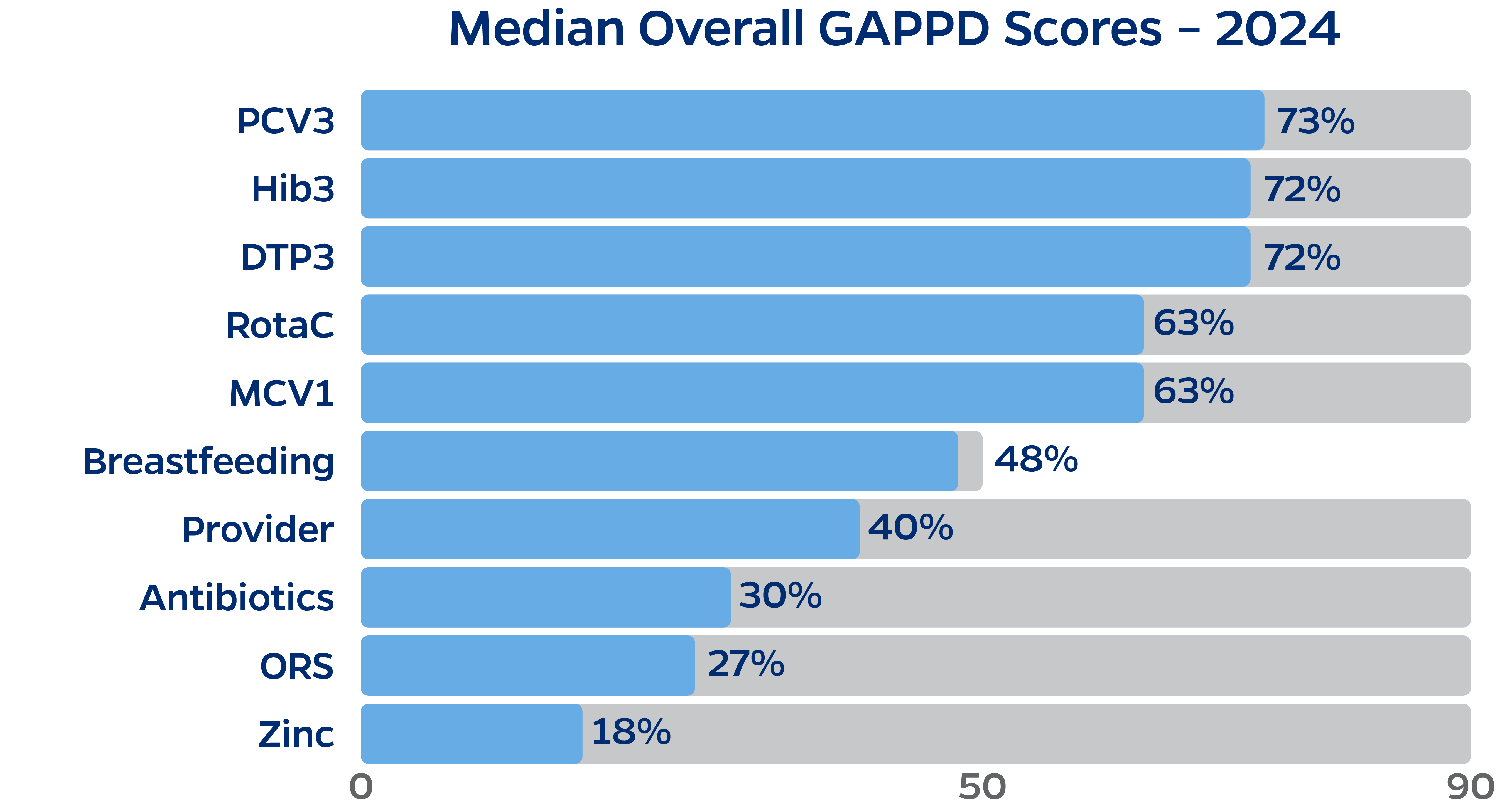Tracking Progress Toward Pneumonia and Diarrhea Control
Pneumonia and diarrhea remain leading killers of young children around the world, together responsible for 1.17 million annual deaths of children under 5 years old – nearly 1 in 4 deaths among this vulnerable population. Over the past several decades, we’ve made tremendous progress against these diseases, particularly with the introduction and widespread use of vaccines. Still, children are continuing to die, with 70% of under-5 mortality from pneumonia and diarrhea concentrated in just 15 countries, highlighting the urgent need for more equitable access to immunization and other life-saving interventions.
In 2013, the Integrated Global Action Plan for the Prevention and Control of Pneumonia and Diarrhea (GAPPD) identified an integrated framework of key interventions proven to effectively protect, prevent, and treat childhood pneumonia and diarrhea. Under-5 deaths have significantly decreased since the introduction of this plan, but we are nowhere near the ambitious goal of ending preventable childhood deaths due to pneumonia and diarrhea by 2025.
For more than a decade, the International Vaccine Access Center (IVAC) at the Johns Hopkins Bloomberg School of Public Health has analyzed progress for 10 key GAPPD interventions in the 15 countries with the highest burden of under-5 deaths from pneumonia and diarrhea and summarized them in an annual Pneumonia and Diarrhea Progress Report (PDPR). These interventions include coverage of five vaccines (third dose of diphtheria, tetanus, and pertussis [DTP3] vaccine; first dose of measles-containing vaccine [MCV1]; third dose of Haemophilus influenzae type b [Hib3] vaccine; third dose of pneumococcal conjugate vaccine [PCV3]; and final recommended dose of rotavirus vaccine [RotaC]), as well as treatments including antibiotics for children with suspected pneumonia and oral rehydration solution for children with diarrhea. Intervention coverage levels are averaged to create overall, diarrhea, and pneumonia GAPPD scores for each country.

Findings from the 2024 PDPR are summarized below.
- The countries included in this year’s report are Angola, Cameroon, Chad, Democratic Republic of the Congo, Ethiopia, India, Ivory Coast, Madagascar, Mali, Niger, Nigeria, Pakistan, Somalia, Sudan, and United Republic of Tanzania. Altogether, there were more than 850,000 under-5 deaths from pneumonia and diarrhea in 2021 in these 15 countries.
- The mean overall GAPPD score (encompassing all 10 indicators) across these countries was 50%, a slight increase from the 2023 report. No single country achieved the overall GAPPD score target of 86%.
- Scores for pneumonia indicators ranged from 31% (Somalia) to 77% (United Republic of Tanzania), with a mean score of 56%. This represents a slight increase from the 2023 report.
- Scores for diarrhea indicators ranged from 20% (Somalia) to 68% (India), with a mean score of 43%. This represents a slight increase from the 2023 report.
Notable successes include:
- India saw an increase in PCV3 coverage of 17 percentage points (from 66% to 83%), thanks in part to the country’s nationwide introduction of PCV in November 2021. There were more than 27,500 fewer under-5 pneumonia and diarrhea deaths in India compared to the previous year, a decrease of nearly 19%.
- After introducing universal rotavirus vaccination in 2022, Nigeria saw RotaC coverage rise dramatically from just 12% to 49%. The number of under-5 deaths due to pneumonia and diarrhea decreased by more than 5%, equal to more than 16,500 lives.
- MCV1 coverage in Niger increased by 15 percentage points to bring the country’s coverage for all five vaccines included in the GAPPD framework to at least 80%, just short of the 90% target.
- Madagascar, Ivory Coast, and Ethiopia saw modest increases in coverage across all vaccines. Although Chad has yet to introduce PCV or rotavirus vaccines, they increased coverage for DTP3, Hib3, and MCV1.
These wins illustrate the potential impact of ensuring that life-saving vaccinations are available to all children, everywhere. Although we are headed in the right direction, there is still significant work to do to achieve this goal. Coverage for all five vaccines decreased in Sudan and Democratic Republic of the Congo, with RotaC coverage dropping by 23 percentage points in Sudan. Chad, Somalia, and several other countries not included in this report have yet to introduce PCV and rotavirus vaccines, although Chad recently introduced PCV and rotavirus into its national immunization program. Vaccine introduction is only one piece of the puzzle, however, as un- and undervaccinated children remain vulnerable to preventable disease even in countries with access to these life-saving vaccines.
“IVAC is pleased to release our annual 2024 Pneumonia and Diarrhea Progress Report on World Pneumonia Day to highlight both the progress and challenges in reducing preventable deaths in young children due to pneumonia and diarrhea. The report highlights the huge impact of the introduction of PCV in India and rotavirus vaccine in Nigeria in reducing deaths due to pneumonia and diarrhea. Yet much more needs to be done to protect young children from these preventable diseases.”
- Dr. William Moss, IVAC Executive Director
Country profiles are available to download for each of the 15 high-burden countries to guide country-level immunization decisions and advocacy work. These one-page reports display country-specific disease burden data, GAPPD scores, and performance for each GAPPD indicator compared to the previous year and to other countries. Additionally, disease burden data and GAPPD indicator scores are available for 194 countries on VIEW-hub, IVAC’s interactive, map-based data visualization platform.



